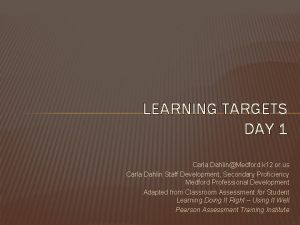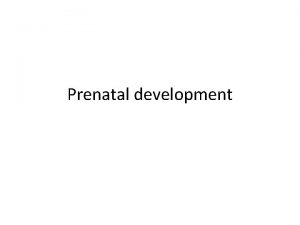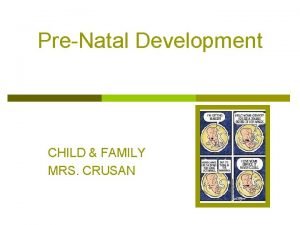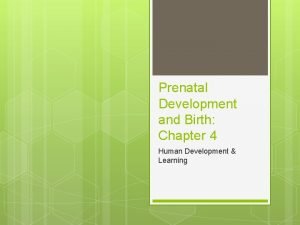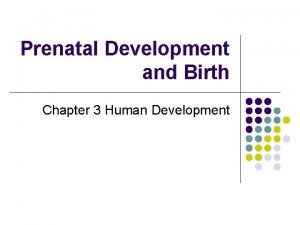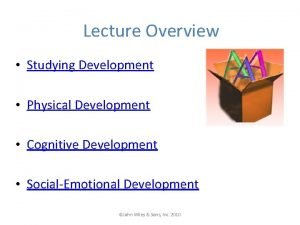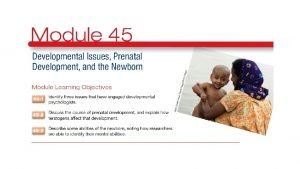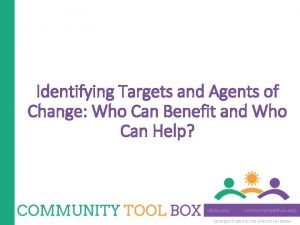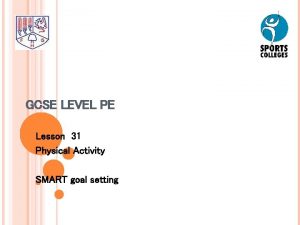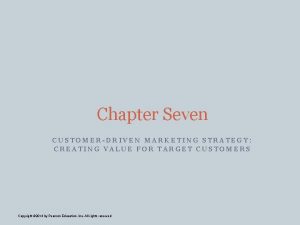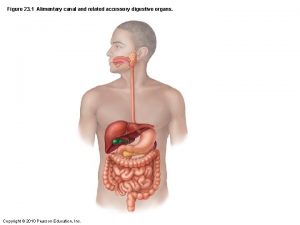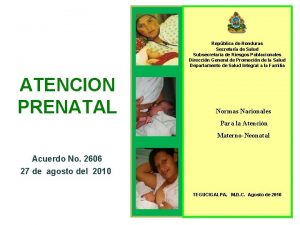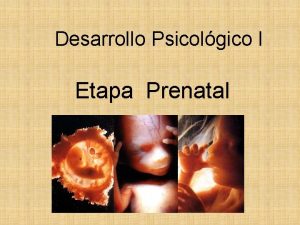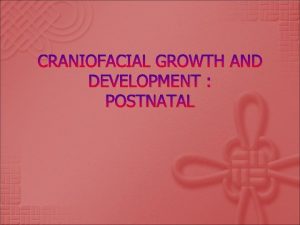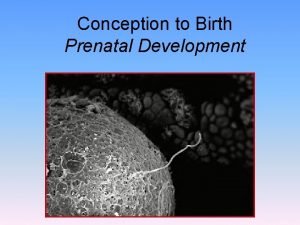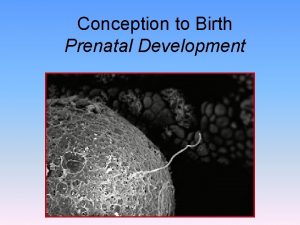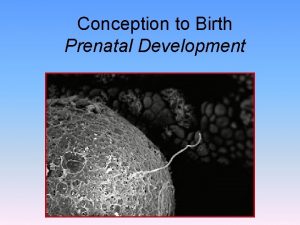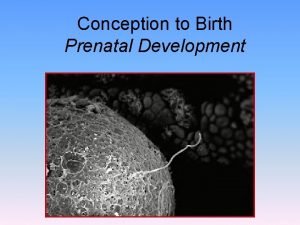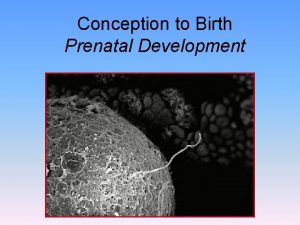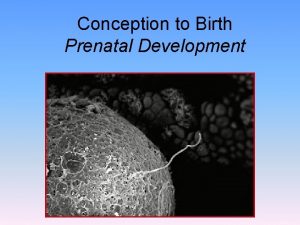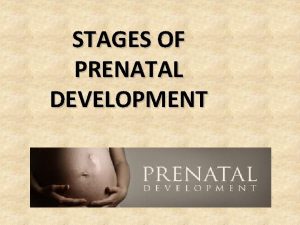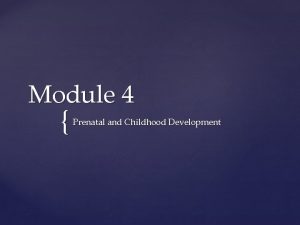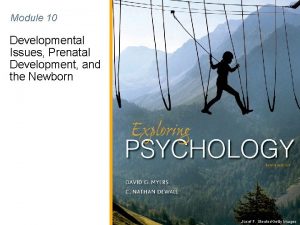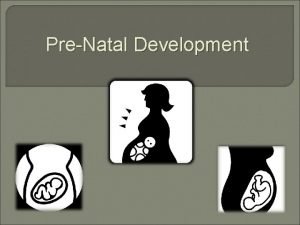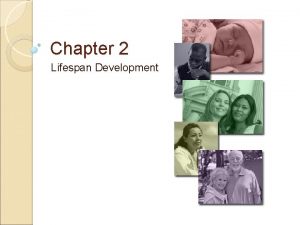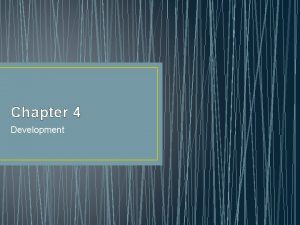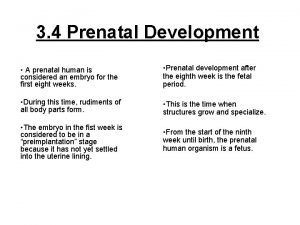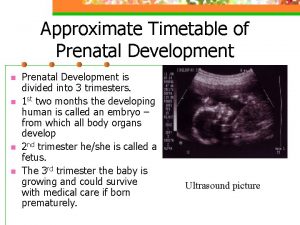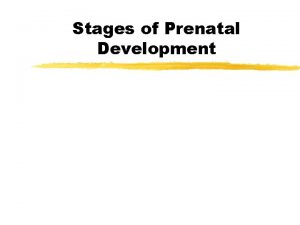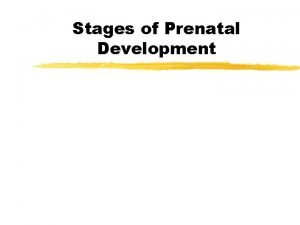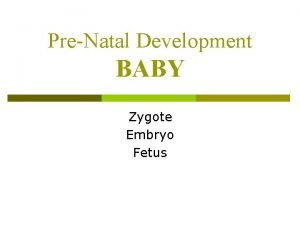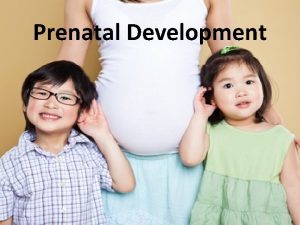Learning Targets Module 45 Developmental Issues Prenatal Development












































- Slides: 44


Learning Targets Module 45 Developmental Issues, Prenatal Development, and the Newborn 45 -1 Identify three issues that have engaged developmental psychologists. 45 -2 Discuss the course of prenatal development, and explain how teratogens affect that development. 45 -3 Describe some abilities of the newborn, and explain how researchers are able to explore infants’ mental abilities.

What is developmental psychology? a branch of psychology that studies physical, cognitive, and social change throughout the life span

What three issues have engaged developmental psychologists? nature and nurture How does our genetic inheritance (nature) interact with experiences (nurture) to influence our development? continuity and stages What parts of development are gradual and continuous and what parts change abruptly in separate stages? stability and change Which of our traits persist through life? How do we change as we age?

AP® Exam Tip 1 All three of these issues, nature and nurture, continuity and stages, stability and change, are important for development. Nature and nurture, of course, weave their way through almost every module. Look for the nature/nurture idea throughout this text (and on the AP® exam).

Consider this quote… “ Nature is all that a man brings with him into the world; nurture is every influence that affects him after his birth. ” ~Francis Galton, English Men of Science, 1874 What did you bring in the world and what has affected you since your birth? Can you identify the elements of nature and nurture in you?

How do genes form our nature? The gene combination created by the merging of our mother’s egg with our father’s sperm helped form us as individuals. Genes predispose both our shared humanity and our individual differences.

How does our environment shape our nurture? But our experiences also form us, in the womb and in the world. Even differences rooted in our nature may be strengthened by our nurture. We are not formed by either nature or nurture, but by their interrelationships—their interaction. Biological, psychological, and social-cultural forces interact.

Does growth happen continuously or in stages? Do adults differ from infants as a giant redwood differs from its seedling—a difference created by gradual, cumulative growth? Or do they differ as a butterfly differs from a caterpillar— a difference of distinct stages?

How do stage theorists view development? Stage theorists, who emphasize biological maturation tend to see development as a sequence of genetically predisposed stages or steps. Although progress through the various stages may be quick or slow, everyone passes through the stages in the same order.

What evidence supports theory of stable development over time? One research team that studied 1000 people from ages 3 to 38 was struck by the consistency of temperament and emotionality across time. (Moffitt et al. , 2013; Slutske et al. , 2012) Out-of-control 3 -year-olds were the most likely to become teen smokers, adult criminals, or out-of-control gamblers.

What additional research on nature v. nurture exists? In another study, 6 -year-old Canadian boys with conduct problems were four times more likely than other boys to be convicted of a violent crime by age 24. (Hodgins et al. , 2013)

Can temperament predict divorce? In one longitudinal study of 306 college alums, 1 in 4 with yearbook expressions like the on the left later divorced, as did only 1 in 20 with smiles like the on the right. (Hertenstein et al. , 2009)

So, are people’s personalities mostly stable over time? “As at 7, so at 70, ” says a Jewish proverb. People predict that they will not change much in the future. (Quoidbach et al. , 2013) In some ways, they are right. As people grow older, personality gradually stabilizes. (Briley & Tucker-Drob, 2014; Specht et al. , 2014)

But we do change, too, right? Our social attitudes, for example, are much less stable than our temperament, especially during the impressionable late adolescent years. (Krosnick & Alwin, 1989; Rekker et al. , 2015) Older children and adolescents learn new ways of coping. Although delinquent children have elevated rates of later problems, many confused and troubled children blossom into mature, successful adults. (Moffitt et al. , 2002; Roberts, et al. , 2013; Thomas & Chess, 1986).

Are both stability and change important? Life requires both stability and change. Stability provides our identity, enabling us to depend on others and on ourselves. Our potential for change gives us our hope for a brighter future, allowing us to adapt and grow with experience.

Ask yourself. Are you the same person you were as a preschooler? As an 8 -year-old? As a 12 -year-old? How are you different? How are you the same? Does the research on stability of personality over time sound correct to you? Can you relate?

AP® Exam Tip 2 Almost every topic in psychology holds personal relevance, but development stands out. As you work your way through this unit, think of how the material relates to you, your relatives, and your friends. The more often you do this, the easier it will be to remember the material. You learned in Module 31 that making material personally meaningful enhances processing and later recall.

What is the course of prenatal development? Life begins at conception and continues through several stages in the womb.

How does conception occur? The path to life begins with the release of an egg from the mother’s ovary. 250 million deposited sperm approach an egg cell 85, 000 times their own size. The small number reaching the egg released digestive enzymes that eat away the egg’s protective coating.

How is the egg fertilized? One sperm penetrates the coating and enters through the egg’s surface blocking out the other sperm. Within hours, the egg nucleus and the sperm nucleus fuse: the two become one.

What happens in the germinal stage of prenatal development? The germinal stage, the first 10 -day to 2 -weeks of development is when the fertilized egg, called a zygote, undergoes rapid cell division. One cell becomes 2, then 4—each just like the first— until the cell division produces some 100 identical cells within the first week. The cells then begin to differentiate—to specialize in structure and function to become brain tissue, intestine tissue, heart tissue, etc.

How does the zygote become an embryo? About 10 days after conception, the germinal stage completes as the zygote attaches to the mother’s uterine wall, beginning approximately 37 weeks of the closest human relationship. A healthy and well-nourished mother helps form a healthy baby-to-be. Over the next 6 weeks, the embryo’s organs begin to form and function. The heart begins to beat.

How does the zygote become an embryo? Cont. The zygote’s inner cells become the embryo. Many of its outer cells become the placenta, the life-link that transfers nutrients and oxygen from mother to embryo.

How does an embryo become a fetus? By 9 weeks after conception, an embryo looks unmistakably human. It is now a fetus (Latin for “offspring” or “young one”). During the sixth month, organs such as the stomach develop enough to give the fetus a good chance of surviving and thriving if born prematurely.

What happens in the fetal stage? By the start of the ninth week, when the fetal period begins, facial features, hands, and feet have formed.

How big is a fetus? As the fetus enters the 16 th week, its 3 ounces could fit in the palm of your hand.

1. What Would You Answer? What is the prenatal development sequence? A. zygote, fetus, embryo B. fetus, zygote, embryo C. embryo, zygote, fetus D. zygote, embryo, fetus E. fetus, embryo, zygote

What does research show about the development of language in the womb? After repeatedly hearing a fake word (tatata) in the womb, Finnish newborns’ brain waves displayed recognition when hearing the word after birth. (Partanen et al. , 2013) If their mother spoke two languages during pregnancy, newborns display interest in both. (Byers-Heinlein et al. , 2010) And just after birth, the melodic ups and downs of newborns’ cries bear the tuneful signature of their mother’s native tongue. (Mampe et al. , 2009)

What are teratogens? (literally, “monster makers”) agents, such as chemicals and viruses, that can reach the embryo or fetus during prenatal development and cause harm

Can you think of examples of teratogens?

Examples of teratogens alcohol consumption by the mother tobacco use by the mother viruses contracted by the mother drug use (cocaine, meth, etc. ) by the mother certain medications taken by the mother

How does alcohol impact the fetus? “ You shall conceive and bear a son. So then drink no wine or strong drink. ” Judges 13: 7 A pregnant woman never smokes or drinks alone. When alcohol enters her bloodstream, and that of her fetus, it reduces activity in both their central nervous systems.

What are the implications for the fetus when the mother drinks during pregnancy? Alcohol use during pregnancy may prime the woman’s offspring to like alcohol and put them at risk for heavy drinking and alcohol use disorder during their teen years. In experiments, when pregnant rats drank alcohol, their young offspring later displayed a liking for alcohol’s taste and odor. (Youngentob et al. , 2007, 2009)

How does maternal drinking affect the fetus? Even light drinking or occasional binge drinking can affect the fetal brain. (Braun, 1996; Marjonen et al. , 2015) Persistent heavy drinking puts the fetus at risk for a dangerously low birth weight, birth defects, future behavior problems, and lower intelligence.

What is fetal alcohol syndrome? For 1 in about 700 children, the effects are visible as fetal alcohol syndrome (FAS), the most serious of all fetal alcohol spectrum disorders, marked by lifelong physical and mental abnormalities. (May et al. , 2014)

2. What Would You Answer? Juliette is experiencing lifelong physical and mental abnormalities because her mother consumed alcohol while she was pregnant. The alcohol, because of the damage it caused, is considered a(n) A. reflex. B. embryo. C. teratogen. D. epigenetic. E. zygote.

What adaptive reflexes is the newborn equipped with? When something touches their cheek, babies turn toward that touch, open their mouth, and vigorously root for a nipple. Finding one, they automatically close on it and begin sucking. Other adaptive reflexes include the startle reflex (when arms and legs spring out, quickly followed by fist clenching and loud crying) and the surprisingly strong grasping reflex, both of which may have helped infants stay close to their caregivers.

chart of infant reflexes

What is habituation and how is it used to study infants? decreasing responsiveness with repeated stimulation As infants gain familiarity with repeated exposure to a stimulus, their interest wanes and they look away sooner. The novel stimulus gets attention when first presented. With repetition, the response weakens. This seeming boredom with familiar stimuli gives us a way to ask infants what they see and remember.

3. What Would You Answer? As infants gain familiarity with repeated exposure to a visual stimulus, their interest wanes and they look away sooner. The decrease in an infant’s responsiveness is called A. concentration. B. teratogens. C. habituation. D. stability. E. transference.

Learning Target 45 -1 Review Identify three issues that have engaged developmental psychologists. § Developmental psychologists study physical, mental, and social changes throughout the life span. § They focus on three issues: nature and nurture (the interaction between our genetic inheritance and our experiences); continuity and stages (which aspects of development are gradual and continuous, and which change relatively abruptly); and stability and change (whether our traits endure or change as we age).

Learning Target 45 -2 Review Discuss the course of prenatal development, and explain how teratogens affect that development. § The life cycle begins at conception, when one sperm cell unites with an egg to form a zygote. § The zygote’s inner cells become the embryo, and in the next 6 weeks, body organs begin to form and function. § By 9 weeks, the fetus is recognizably human. § Teratogens are potentially harmful agents, such as viruses or drugs, that can pass through the placental screen and harm the developing embryo or fetus, as happens with fetal alcohol syndrome.

Learning Target 45 -3 Review Describe some abilities of the newborn, and explain how researchers are able to explore infants’ mental abilities. § Babies are born with sensory equipment and reflexes that facilitate their survival and their social interactions with adults. For example, they quickly learn to discriminate their mother’s smell, and they prefer the sound of human voices. § Researchers use techniques that test habituation, such as the visual-preference procedure, to explore infants’ abilities.
 Juliette is experiencing lifelong
Juliette is experiencing lifelong Writing learning targets
Writing learning targets Agonist antagonist muscles
Agonist antagonist muscles Willingham fire
Willingham fire Knowledge targets examples
Knowledge targets examples Learning targets knowledge, reasoning, skill product
Learning targets knowledge, reasoning, skill product Learning target
Learning target Prenatal development stages
Prenatal development stages 3 stages of prenatal development
3 stages of prenatal development Periods of prenatal development
Periods of prenatal development Prenatal development
Prenatal development Three prenatal stages
Three prenatal stages Prenatal development
Prenatal development What 3 issues have engaged developmental psychologists
What 3 issues have engaged developmental psychologists Cuadro comparativo de e-learning
Cuadro comparativo de e-learning C device module module 1
C device module module 1 Warehousing objectives
Warehousing objectives Jim crow laws in what region or regions did it exist
Jim crow laws in what region or regions did it exist Brides magazine targets consumers who are in
Brides magazine targets consumers who are in Targets of change
Targets of change Smart gcse pe
Smart gcse pe Identifying market segments and targets chapter 9
Identifying market segments and targets chapter 9 Identifying market segments and targets chapter 9
Identifying market segments and targets chapter 9 Identifying market segments and targets chapter 9
Identifying market segments and targets chapter 9 Nyseslat targets of measurement
Nyseslat targets of measurement The nfl targets several different market segments
The nfl targets several different market segments Early childhood education barbados
Early childhood education barbados Five patterns of target market selection
Five patterns of target market selection Physical targets
Physical targets Icsa idsc 모니터링 접근방식
Icsa idsc 모니터링 접근방식 Segment by segment invasion
Segment by segment invasion Parathyroid gland chief cell
Parathyroid gland chief cell Drag the appropriate labels to their respective targets.
Drag the appropriate labels to their respective targets. Europe 2020 targets
Europe 2020 targets Europe 2020 targets
Europe 2020 targets Alohahsap
Alohahsap On training targets for supervised speech separation
On training targets for supervised speech separation How to restart iptables
How to restart iptables Identifying market segments and targets
Identifying market segments and targets Carnet prenatal honduras
Carnet prenatal honduras Prenatal massage definition
Prenatal massage definition Zhvillimi i fetusit
Zhvillimi i fetusit Importancia del desarrollo fisico
Importancia del desarrollo fisico Desarrollo prenatal
Desarrollo prenatal Theories of craniofacial growth
Theories of craniofacial growth




